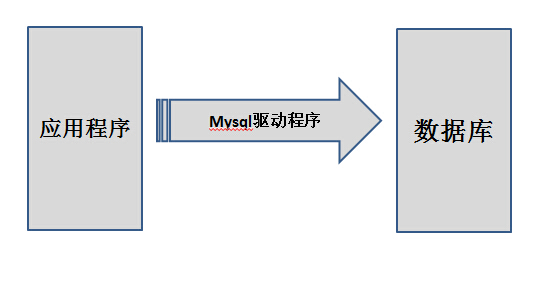从这篇开始学习Spring的JDBC,为了了解Spring对于JDBC的作用,先通过JDBC传统的流程,实现一个数据库的插入和读取。
从这篇你可以了解到:
1 传统的JDBC插入和读取的过程。
2 如何通过JDBC连接Mysql
如何通过JDBC连接mysql
首先看一下下面这张图:

应用程序需要通过mysql的驱动程序,才能与数据连接。
驱动程序下载地址:mysql-connector-java-5.1.13-bin.jar
在设计程序的时候,应该采用接口编程的方式,这样能够减小数据操作与应用业务逻辑代码之间的耦合。

JDBC插入和读取过程
使用传统的JDBC需要经过如下的几个步骤:
1 加载驱动程序
Class.forName("com.mysql.jdbc.Driver");
2 创建连接
Connection conn = (Connection) DriverManager.getConnection(url, userName,passwrod);
3 创建执行计划
PreparedStatement pstmt = (PreparedStatement) conn.prepareStatement("select * from persons");
4 执行查询获取结果
ResultSet rs = pstmt.executeQuery(); while (rs.next()) { System.out.println("id : " + rs.getString(1) + " name : "+ rs.getString(2) + " age : " + rs.getInt(3)); }
5 关闭查询结果
if (rs != null) { try { rs.close(); } catch (SQLException e) { e.printStackTrace(); } }
6 关闭执行计划
if (pstmt != null) { try { pstmt.close(); } catch (SQLException e) { e.printStackTrace(); } }
7 关闭连接
if (conn != null) { try { conn.close(); } catch (SQLException e) { e.printStackTrace(); } }
按照上面的几个步骤,来看一下实现的代码:
首先是接口部分:
package com.spring.chap5.dao; public interface OldJdbc { /** * 插入数据 */ public void insertPerson(String id,String name,int age); /** * 查询所有结果 */ public void findAllPerson(); }
然后是实现部分
package com.spring.chap5.dao; import java.sql.DriverManager; import java.sql.ResultSet; import java.sql.SQLException; import com.mysql.jdbc.Connection; import com.mysql.jdbc.PreparedStatement; public class OldJdbcImpl implements OldJdbc{ String driver = "com.mysql.jdbc.Driver"; String userName = "root"; String passwrod = "123qwe"; String url = "jdbc:mysql://localhost:3306/test"; public void insertPerson(String id,String name,int age) { try { Class.forName(driver); Connection conn = (Connection) DriverManager.getConnection(url, userName,passwrod); PreparedStatement pstmt = (PreparedStatement) conn.prepareStatement("insert into persons (id,name,age) values (?,?,?)"); pstmt.setString(1, id); pstmt.setString(2, name); pstmt.setInt(3, age); pstmt.executeUpdate(); if (pstmt != null) { try { pstmt.close(); } catch (SQLException e) { e.printStackTrace(); } } if (conn != null) { try { conn.close(); } catch (SQLException e) { e.printStackTrace(); } } } catch (Exception e) { e.printStackTrace(); } } public void findAllPerson() { try { Class.forName(driver); Connection conn = (Connection) DriverManager.getConnection(url, userName,passwrod); PreparedStatement pstmt = (PreparedStatement) conn.prepareStatement("select * from persons"); ResultSet rs = pstmt.executeQuery(); while (rs.next()) { System.out.println("id : " + rs.getString(1) + " name : "+ rs.getString(2) + " age : " + rs.getInt(3)); } if (rs != null) { try { rs.close(); } catch (SQLException e) { e.printStackTrace(); } } if (pstmt != null) { try { pstmt.close(); } catch (SQLException e) { e.printStackTrace(); } } if (conn != null) { try { conn.close(); } catch (SQLException e) { e.printStackTrace(); } } } catch (Exception e) { e.printStackTrace(); } } }
可以看到,光是两个简单的插入和查询,就有如此多的代码,而且大部分都是相同的过程。因此spring的模板,就派上用场了。
测试类如下:
public class test { public static void main(String[] args) { OldJdbc oldjdbc = new OldJdbcImpl(); oldjdbc.insertPerson("001", "xingoo1", 20); oldjdbc.insertPerson("002", "xingoo2", 20); oldjdbc.findAllPerson(); } }
另外还需要一个很重要的部分,就是sql语句:
/* SQLyog v4.05 Host - 4.1.11-nt : Database - test ********************************************************************* Server version : 4.1.11-nt */ create database if not exists `test`; USE `test`; /*Table structure for table `test`.`persons` */ drop table if exists `test`.`persons`; CREATE TABLE `persons` ( `id` varchar(20) NOT NULL default '', `name` varchar(20) default NULL, `age` int(10) default NULL, PRIMARY KEY (`id`) ) ENGINE=InnoDB DEFAULT CHARSET=latin1; /*Data for the table `test`.`persons` */ insert into `test`.`persons` values ('001','xingoo1',20),('002','xingoo2',20);